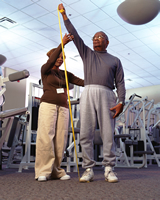New Therapies and Research

Treatments for Muscle Stiffness and Spasticity
Botulin Toxin Injections
Botulinum toxin, often known as Botox®, improves muscle stiffness and spasticity in stroke survivors. Botulinum toxin injections lessen spasticity because they block the release of acetylcholine. Acetylcholine is a chemical that nerve cells release to contract muscles. Research has found that botulinum toxin injections are safe and lessen disability in patients with muscle spasticity.
• Use of botulinum toxin in stroke patients with severe upper limb spasticity http://www.ncbi.nlm.nih.gov/pmc/articles/PMC486452/
• Randomized DB controlled trial of botulinum toxin A in hemiplegic shoulder pain and spasticity http://www.ncbi.nlm.nih.gov/pubmed/23064478
Treatments to Improve Hand and Arm Function
Constraint-Induced Movement Therapy
Constraint Induced Movement Therapy (CIMT) helps stroke survivors regain strength in their weakened hands and arms. Often, the unaffected arm (i.e., strong arm) is placed in a sling or splint to restrain movement for about two weeks. A weakened hand may be placed in a glove or mitt. The sling or mitt forces the patient to use the weak limb during exercises and daily tasks. Research has found that this therapy improves limb movement after a stroke.
• American Stroke Association: Improving Fine Motor Skills https://www.stroke.org/en/about-stroke/effects-of-stroke/physical-effects-of-stroke/physical-impact/improving-fine-motor-skills
• Constraint-Induced Movement Therapy (CIMT): Current perspectives and future directions http://www.ncbi.nlm.nih.gov/pmc/articles/PMC3345246/
• Study to assess the effectiveness of modified constraint-induced movement therapy in stroke subjects: A randomized controlled trial http://www.ncbi.nlm.nih.gov/pmc/articles/PMC3724070/
Electrical Stimulation
Electric Stimulation sends a shock to the stroke survivor’s weak limb. The shock forces the nerves and muscles to move. Electric stimulation is often done at a rehabilitation center. Devices for electrical stimulation can also be purchased for use at home. This therapy improves the stroke patient’s chances for restoring movements to affected or weakened limbs.
• American Stroke Association: Functional Electrical Stimulation https://www.stroke.org/en/about-stroke/effects-of-stroke/physical-effects-of-stroke/physical-impact/functional-electrical-stimulation
Mental Practice
Mental practice focuses on repeating a physical skill or exercise to improve limb function. Patients who do mental practice after physical therapy improve faster than patients who just relax afterwards. Added benefits may occur when mental practice is combined with constraint induced movement therapy (CIMT).
• The impact of mental practice on stroke patients' postural balance http://www.sciencedirect.com/science/article/pii/S0022510X12003644
Mirror Therapy
This therapy is done by placing a mirror vertically in the middle of the body. It shows the reflection between the affected (weak) and unaffected (strong) side. The stroke survivor performs the same motion with both arms while watching the mirror. This makes it appear that both arms are moving normally.
• The value of adding mirror therapy for upper limb motor recovery of subacute stroke patients: A randomized controlled trial http://www.ncbi.nlm.nih.gov/pubmed/23480975
• Mirror therapy for improving motor function after stroke http://www.ncbi.nlm.nih.gov/pubmed/22419334
Robotic Therapy
Robotic Therapy uses machines to improve the function of a weakened limb. These machines help stroke survivors make movements easier. With practice, this therapy will improve limb movement. Robotic therapy is a new technique. Robotic therapy replaces the manual method which involved therapists helping patients to move each limb repetitively.
• Robots to get stroke patients back on their feet http://www.sciencedaily.com/releases/2013/03/130311091309.htm
• Robotic therapy helps stroke patients regain function http://newsoffice.mit.edu/2010/stroke-therapy-0419
More Resources 
Additional credible resources on this topic can be found here. Website pages may change or update, therefore if a link does not work, you may also try to type the information into your internet search bar. This Resource List will be updated frequently.
|
*Link Disclaimer: Links to information and Web sites outside of the Department of Veterans Affairs do not indicate an endorsement of products or services offered by the sites. In addition, these sites may have privacy and security policies that are inconsistent with those of VA. |
These materials were created for the project:
Web-Based Informational Materials for Caregivers of Veterans Post-Stroke
Project Number SDP 06-327 funded by VA HSR&D Quality Enhancement Research Initiative (QUERI)



















